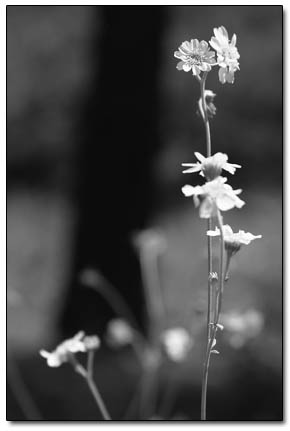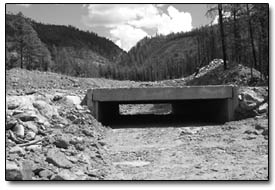 |
A bright bloom stands in
sharp contrast to the backdrop of a scorched tree in the
Missionary Ridge Burn
Area. Local officials are saying that revegetation efforts,
coupled with Mother Nature’s own natural reflexes,
have begun to rejuvenate the areas burned in last year’s
fires./Photo by Todd Newcomer. |
In the aftermath of last summer’s wildfires, national
and local officials predicted a bleak future for the Durango
area. Biblical levels of flooding combined with mudslides and
ash and debris flows were expected to hit for years to come.
It’s now been more than a year since the fires were successfully
contained, and those prophecies have not come to pass. A great
deal of manpower went into averting the disasters, but officials
agree that luck has played the biggest hand.
Last summer, the Missionary Ridge and Valley fires scorched
more than 70,000 acres, engulfed and destroyed 56 homes, and
came within 5 miles of the Durango city limits. The fires also
wiped the landscape clean, denuding it of any vegetation and
creating an optimum situation for flooding. Last fall, the rains
hit, and the floods followed, as drainages like Stevens and
Shearer creeks funneled water, mud, ash and debris onto county
roads and properties and into homes. The Animas Valley and the
west side of Vallecito Reservoir became hotspots for flooding,
and there was belief that they would be disaster areas for at
least five years to come.
So far, this summer has defied that prediction. Last fall,
La Plata County Engineer Rick Routh was on the front lines of
the flood scene, working to keep county roads 250 and 501 clear
of mud and debris and open to traffic. This summer, Routh has
been far less preoccupied with flooding.
“The amount of road closures and road damage has been
somewhat minimal,” he said, citing numerous reasons for
the absence of disaster. Chief among these is that rainfall
has been adequate but not excessive, according to Routh.
“The intensity of the rains hasn’t been to a level
that we’ve seen before in Durango,” he said. “We’ve
been lucky. Where it has been intense, it hasn’t been
centered over the troublesome drainages.”
Routh added, “Instead of intense rains that erode all
of the vegetation, the lighter rains have helped vegetation
get established. There are already, brand new 6-foot aspens
in the burn area.”
Routh also said that when bad luck has struck, county crews,
headed up by Doyle Villers, director of maintenance, and Butch
Knowlton, director of emergency preparedness, have responded
quickly and precisely. “Our road crews have got it figured
out,” he said. “They’re able to put the men
and equipment in the locations that are most likely to receive
mud and debris and get the roads open as soon as they can.”
Early warning systems, the substantial work conducted last
fall to reseed, improve roads and enlarge culverts, and neighborhood
awareness also have helped avert disaster, according to Routh.
“The residents of the county have been fantastic in terms
of working with their neighbors to avert the flooding and in
some cases accept that there will be property damage,”
he said. “That’s been helpful for us in managing
this crisis that will be with us for a long, long time.”
The San Juan National Forest also has been working since last
fall to manage the crisis. Nearly 18,000 acres of the most severely
scorched areas of Missionary Ridge were reseeded by air with
native and established grasses. Log erosion barriers were erected,
ground cover was spread, and larger culverts were installed
– all in an attempt to slow erosion. Looking back, Kay
Zillich, San Juan National Forest hydrologist, said these efforts
have been somewhat successful.
“There are a lot of sprouts of aspen and oak, some of
which are head high,” she said. “Plants like lupine
and Oregon grape are coming on strong. All in all, we’ve
got decent revegetation going.”
But more than the ambitious reseeding effort, Zillich credited
nature’s resilience for the recovery of the burn area.
“Some of the revegetation is what we applied from airplanes
last fall,” she said. “Most of it is coming back
on its own.”
 |
An underpass was built along
County Road 250 to help prevent accidents and road closures
due to mud slides. So far this summer, road closures and
road damage
because of flooding have been minimal, according to county
engineer Rick Routh./Photo by Todd Newcomer. |
Citing an example of a remarkable comeback, Zillich said that
a small yellow flower was discovered this spring in numerous
locations but could not be identified by Forest Service botanists.
Prior to reseeding, all of the seeds had been screened in an
effort to prevent the spread of noxious weeds, but the yellow
flower appeared to be one that slipped through the cracks. Eventually,
it was determined that the flower is a fire-dependent native
species called golden smoke.
“These seeds have been waiting 100 years for this kind
of event to germinate,” Zillich said. “I’m
really impressed by the resiliency of the natural ecosystem.
Mother nature knows what to do.”
Zillich said that revegetation has played a part in the lack
of flooding this summer. But like Routh, she said it is a small
part, and that La Plata County has gotten lucky and dodged dangerous
rains.
“The revegetation is part of why we haven’t seen
the big floods, but most of it is that we haven’t seen
the big rains,” she said. “The active cells that
rain hard have been small, and we just haven’t gotten
enough rain in one spot for it to be a problem.”
Zillich added that real progress in the realm of revegetation
will take several years. She said that the duff layer, the several
inches of decomposed leaf and pine needles covering forest floors,
has been completely wiped out in many areas. The duff layer
is the basis of forest vegetation, according to Zillich. “In
numerous cases, we lost the entire duff layer to the fire,”
she said. “It’ll take at least two years for that
to return to normal.”
Still, both Zillich and Routh agree that the situation is a
shining one compared to what may have happened. They also are
holding their breath, hoping that the worst-case scenario does
not strike in coming months.
“We’re real happy, but it could change tomorrow,”
Routh said. “If the heavy rains that hit the Southwest
county on Sunday had hit the Stevens Creek drainage, it could
have done some serious damage. We’re very much at the
mercy of Mother Nature. Our efforts would be for naught if we
had even a five-year rain event.”
Routh acknowledged that moisture has been steady throughout
the second half of this summer but noted that historically,
the region’s biggest floods have hit during the fall months.
“Historically, September and October have had the largest
rain events of any time of the year,” he said. “We’re
still very exposed in the Missionary Ridge and Valley Fire areas.”
Zillich agreed, saying, “We’ve been lucky and we’re
doing really well, but we’ve got at least another month
before I’m going to relax.”

